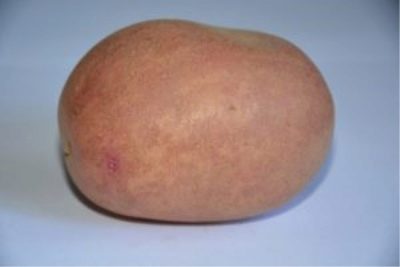
- Authors: SPC NAS of Belarus for potato growing, RB
- Appointment: table, suitable for making French fries, chips
- Tuber weight, g: 180-200
- Peel color: red
- Color of the pulp: yellow
- Starch content,%: up to 18.3%
- Tuber shape: rounded oval
- Peel structure: smooth
- Eyes: none
- The soil: light and medium in terms of particle size distribution
Among the many types of vegetables grown by summer residents and farmers, potatoes are the most popular. The main thing is to choose a variety that quickly adapts to the climate of the region, and gives high yields. These are the types of potatoes Lel of Belarusian selection.
Description of the variety
The Lel potato, bred at the Scientific Research Center of the National Academy of Sciences of Belarus for potato growing and entered in the Belarusian register in 2017, is a medium-sized bush of an intermediate type. The plant is characterized by: a powerful erect stem, medium foliage with bright green leaves with a slight waviness of the surface and a developed root system, due to which 12-14 large tubers ripen in each bush.
The flowering period of the culture falls on the end of June. At this time, small purple-red flowers appear on the bushes. The flowering period does not last long.
Characteristics of the appearance of the bush and root crops
The variety belongs to the class of large-fruited nightshade crops. On average, the mass of tubers reaches 180-200 grams. The shape of the potato is rounded-oval with a smooth surface, on which there is a light gloss. The peel of the vegetable is thin, but strong, with a minimum number of eyes, which are shallowly set. The color of the potato is uniform - light red.
Dug out potatoes tolerate transportation well, and if stored correctly (at a temperature of + 3 ... 4 degrees and absolute dryness), they can be stored for 5-6 months. Potatoes are best preserved in wooden boxes.
Purpose and taste of tubers
The Belarusian potato variety is famous for its excellent taste and good marketability. The pulp of the vegetable is light yellow. She has a dense, delicate, oily and without pronounced watery consistency. After peeling and heat treatment, the potatoes do not darken. The starch indicator in potatoes is average - less than 18.3%, therefore, the vegetable practically does not boil during cooking. In addition, potato pulp contains a high content of beneficial vitamins and minerals.
A huge advantage of the variety is its universal purpose - potatoes are fried, boiled, baked, added to soups, stewed, used in the preparation of salads and vegetable mixtures. In addition, the variety is massively used for the industrial production of chips.
Maturation
The variety is mid-season. The growing season lasts only 100-110 days. Germination of sprouts and ripening of tubers are amicable. The first digging can be done after 75 days. Massive digging of potatoes occurs in the second half of August.
Yield
Lel potatoes are considered one of the most fruitful. With the provision of intensive agricultural technology, you can get a high yield. On average, about 65.9 tons of healthy and tasty tubers are dug from 1 hectare of plantations.
Growing and care
Potatoes are planted in late April - early May, when return spring frosts are left behind, since the plant does not tolerate them well, and the air temperature warmed up to + 10 ... 12 degrees. Tubers weighing 65-80 grams with good shoots 1.5-2 cm long are selected as planting material. It is not recommended to plant tubers in the place where eggplants, peppers or other nightshade crops used to grow.
Plant care consists of a chain of activities - watering (at least three times per season), fertilization (three times during the growing season), weeding and loosening of row spacings, hilling (after planting and at the end of flowering), disease prevention.

Planting potatoes is one of the main spring activities traditional for Russian gardeners. There are many ways to plant this vegetable, allowing you to get a good harvest in different conditions and climates. Before planting, you need to carefully prepare the planting material, correctly determine the timing, competently prepare the soil.


Soil requirements
Lel, like most other potato varieties, grows and develops well in light soils. The best option would be sandy loam, loamy, peat or black earth mixture. The soil must be fluffy, nutritious, moisture-permeable, breathable and must necessarily have a neutral alkaline index, since potatoes are unproductive in acidic soil, giving poor yields.

Required climatic conditions
Potatoes are a thermophilic and drought-resistant nightshade crop that grows well in the central and southern regions, so they easily tolerate temperature fluctuations, short shade and heat.
It is most comfortable for a plant to grow in an area that is abundantly illuminated by the sun, a sufficient amount of light gets on it during the day, and it is also reliably protected from gusty winds and drafts. It is important that there are no lowlands where moisture stagnates, and boggy, in which the rhizomes of the bushes rot.
Disease and pest resistance
Belarusian potatoes are endowed with high immunity, thanks to which the culture is able to resist cancer and golden nematodes. The plant has an average resistance to late blight of tubers and leaves, common scab, rhizoctonia and black leg. Preventive treatments and spraying will help to resist attacks of insect pests (Colorado potato beetle and bear).

Potatoes are a popular vegetable crop that many gardeners planted on their site. But growing a bountiful harvest of tasty and large tubers is unlikely to succeed if the beds are not properly protected from the most common diseases and pests. Often, the development of diseases of various etiologies of potatoes goes unnoticed, so it is important to identify the problem in time and eliminate it.
















































































